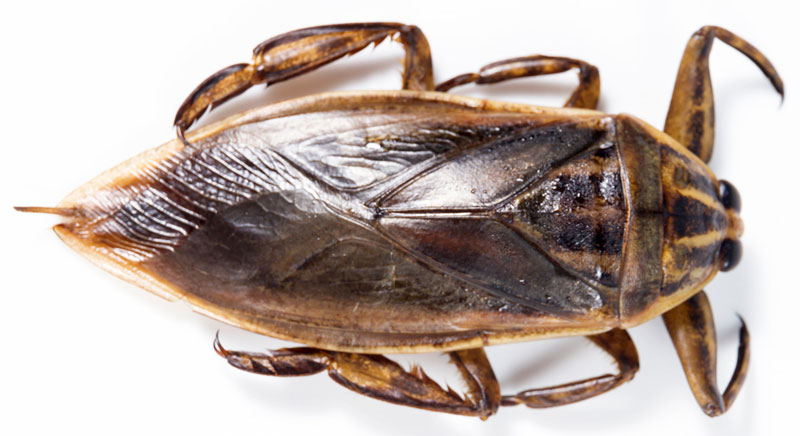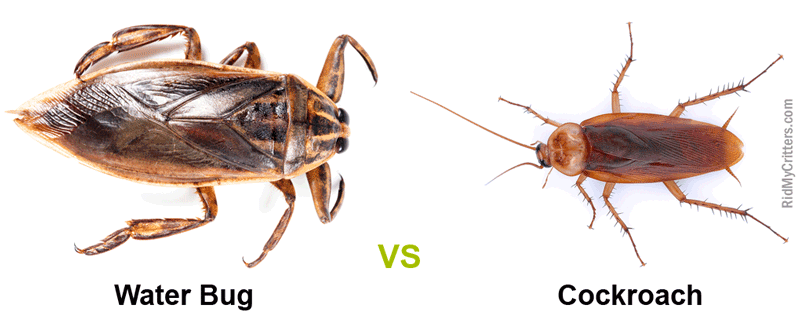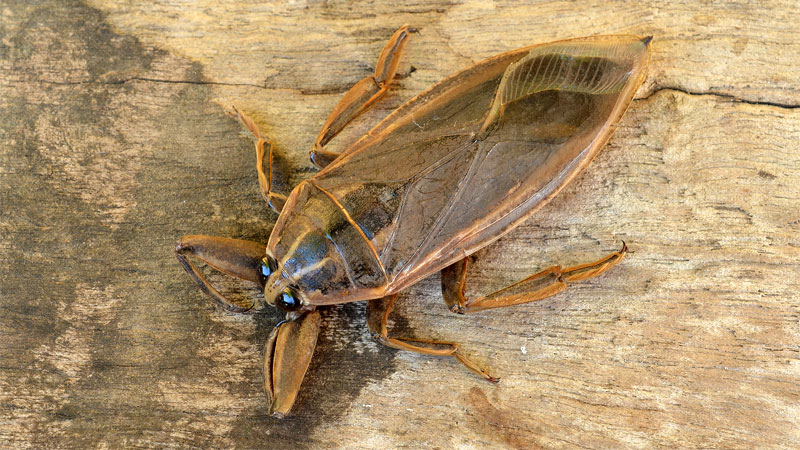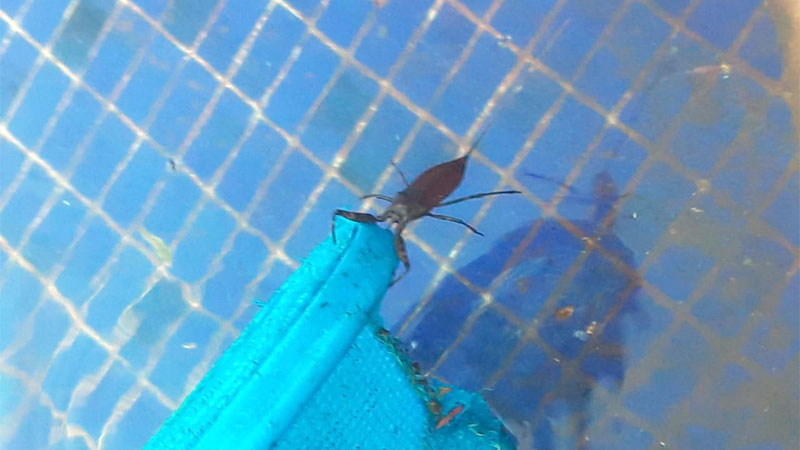There are plenty of different shapes and sizes in the insect world, but certain designs tend to be so successful that unrelated species can easily be mistaken for one another. It gets even more confusing when a particular bug becomes the generic name for any other bug with with similar looks or behaviors.
Such is the case with waterbugs (sometimes spelled as two words). These small bugs love calm lakes and streams but are often confused with cockroaches. Even worse, any bug that can run around on the water is usually referred to as a waterbug.
But fear not! We’re here to help you distinguish between waterbugs and bugs that like water, as well as how to get rid of water bugs in your home or water features.
Getting to Know Water Bugs
Waterbugs aren’t all that bad in the grand scheme of things, but their ability to be confused with nastier bugs can pose a real problem.
What Are Water Bugs?
At the risk of some scientific babble, a large percentage of aquatic and semi-aquatic bugs belong in the suborder Heteroptera under the infraorders Gerromorpha, Leptopodomorpha, and Nepomorpha. The latter contains around 2,000 species referred to as true water bugs, such as water scorpions, backswimmers, toad bugs, the water boatman, and the giant waterbug.
While many types of waterbugs can be a problem, we’ll be focusing on an American species of giant water bug (Lethocerus americanus) and its nearly identical cousin, Benacus griseus.
They have some misleading nicknames, such as alligator fleas, alligator ticks, electric-light bugs, and Indian toe-biters. The nickname “electric-light bugs” is a reference to how they are drawn to lights at night.
Some Waterbug Fun Facts
- The giant waterbug has six legs, with the hind legs flattened out for swimming and the front legs adapted into mandible-like grasping arms that end in hooks.
- Giant water bugs can’t breathe underwater, so they’ve evolved small breathing tubes on their abdomen that inhale air bubbles trapped under the wings, almost like scuba gear.
- Unlike many insects, giant waterbugs have two simple eyes, and their stubby antennae are actually tucked away behind the eyes.
- Their brown to grey colored bodies can measure as long as four inches, although two inches is far more common.
- Some male waterbugs will carry fertilized eggs on their wings until they hatch, while others guard eggs laid on leaves.
- Giant water bugs are a popular food in many parts of Asia.
What Do Water Bugs Eat?
Giant waterbugs are carnivores that hunt in a similar manner to trapdoor spiders. They remain motionless in aquatic plants or debris for amphibians, fish, or aquatic insects to pass by.
Once in range, the waterbug lunges out and grabs the prey in its mandibles, injecting a paralyzing venom that liquefies the insides of the victim. A giant water bug will often hunt prey several times its size.
Water Bug Habitats
These critters like warm, humid locations and spend most of their time in marshes, ponds, and streams. It’s rare for them to venture indoors, and when they do, it’s likely because they’ve been attracted to lights or were attracted by leaks or flooding.
Why Do Water Bugs Come Out at Night?
While they also hunt during the day, the prey of waterbugs are usually most active at night. As a result, you’re more likely to notice them at night, whereas they’re usually hiding during the day.
Do Water Bugs Bite?
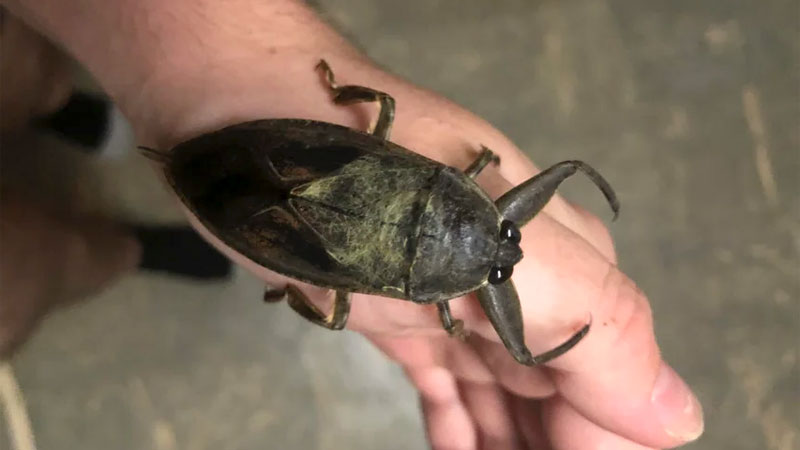
Waterbugs are timid and will try to swim to safety when they encounter a human. On land, they’ll often play dead and even excrete a substance from their anus to give the illusion of death. If further prodded, they’ll raise their front and hind legs in an aggressive stance. Usually, this is enough to deter predators.
However, if you’re unlucky enough to miss these warning signs, these big insects will latch on and bite as if you were prey. The resulting insect bite is very painful and may swell, but the symptoms are gone within about five hours with no serious effects.
They’re also not known to carry any parasites or diseases (unlike their look-alikes the American cockroach and palmetto bug).
Do Water Bugs Fly?
Both the males and females are able to fly and often do so at night. During this time, they may be attracted by artificial lights or the moon’s reflection in backyard ponds.
Do Water Bugs Crawl on Beds?
These aquatic insects prefer the water, so chances are if you see an oval-shaped bug on the bed, it’s a cockroach or similar pest and not a waterbug. And no, it doesn’t make a difference if it’s a waterbed unless you’ve sprung a leak.
Water Bugs vs Cockroaches
One of the most common misconceptions is that waterbugs and cockroaches are the same. They might have a similar body shape but are actually quite different in almost every way.
Roaches have narrower oval bodies, six roughly equal-sized legs, and two long antennae. Their eyes bulge, and a protective plate on the thorax partially conceals their head. At about an inch long, cockroaches generally have shiny black to dark brown bodies.
Conversely, the oval bodies of waterbugs are much broader, and their front legs have been adapted into pincer-like appendages for grabbing prey. Their hind legs are flattened and covered with cilia to allow them to move atop the water. Giant waterbugs range from 1.5 to a whopping four inches long.
Related: 9 Types of Cockroaches
How to Get Rid of Water Bugs
First of all, you’ll need to be sure you’re dealing with an actual water bug infestation. The methods to get rid of roaches or other bugs can vary greatly from those used against waterbugs.
However, once you know these critters are the problem, it’s surprisingly easy to deal with them – at least indoors, that is.
From the Home
These aquatic insects aren’t nearly as fast on land, so you can usually kill them with a simple flyswatter or shoe. They can also be killed with bug zappers.
More importantly, the presence of a giant waterbug in the house is a sign that there may be another infestation, such as silverfish. Even worse, it could mean your water pipes have sprung a leak somewhere.
Check all of the pipes for leaks, as well as your foundation for any sign of seepage or flooding. Clean up any standing water, and lay some diatomaceous earth around the area to kill any critters that had been hiding.
If you find other bugs that the water bug might feed on, be sure to get rid of them. Finally, make sure your windows are properly screened and avoid having porch lights on at night if you live near natural or manmade bodies of water.
From the Pool (or Other Water Feature)
There are a few things to keep in mind when going after these critters outdoors. First of all, don’t expect or try to kill every last one, as they are an important part of the ecosystem.
Second, you may or may not be able to find a waterbug nest. A single female can lay up to 150 eggs in her lifetime (although most nymphs never make it to adulthood). Thus, , while you may kill an adult, its prodigy could still crop back up in a few weeks.
Finally, be sure to use a combination of prevention, natural remedies, and (when necessary) chemical options responsibly, as these bugs are often close to aquatic life you may want to keep alive, such as fish.
See Also: How to Keep Frogs Out of Your Pool
Cleaning the Pool
Algae can attract many types of water bug, such as water boatmen and backswimmers. The presence of these bugs can, in turn, attract giant waterbugs. By using an algaecide or bleach on your pool occasionally, you’ll kill any algae, and the bugs will simply leave.
Once clean, you’ll need to maintain the pool to ensure waterbugs and other pests don’t come back. Here are a few basic points to keep up on when maintaining your pool:
- Cover the pool when you’re not using it.
- Drain the pool if you won’t be using it for long periods of time.
- Ensure the pool water is treated to ensure algae doesn’t form, including regular chlorine treatments.
- Keep the lawn short, as this can keep a wide range of pests away and discourage waterbugs from laying their eggs on any nearby vegetation.
- Turn off any poolside lighting when you’re not actively using the pool at night.
Related: 11 Bugs That Love Swimming Pools
How to Find a Water Bug Nest
When it comes to the giant water bug, their nests will be in the vegetation along the edge of a water feature.
It might be difficult to spot an unguarded nest, but there will be a male waterbug protecting the nest in most cases. Thus you can simply look for the adult to find the eggs.
Natural Killers
Once you find the nest, use a natural treatment to kill them since it’s close to the water. Try sprinkling baking soda or diatomaceous earth over the nest area. The DT will kill the adult and emerging nymphs. Meanwhile, baking soda will draw the water out, dehydrating the adult and eggs.
- Say Goodbye to Bugs – Kills a variety crawling insects including roaches,...
- Attracts and Kills – Made from diatomaceous earth and selected baits, this...
- Mechanical Killer – Unlike many traditional chemical insecticides, insects...
Alcohol is another highly effective weapon, especially rubbing and isopropyl alcohol. Make a spray out of some alcohol and water (you can add garlic or essential oils as well for more potency). Spraying the waterbug and its eggs can dehydrate and kill them on contact.
As for essential oils, many actually ruin the protective wax coating of their exoskeletons when they come into direct contact. Some of the more potent essential oils you can use on water bugs are cedarwood, lemongrass, and peppermint.
Dawn dish soap is an excellent, environmentally friendly bug killer. Just a little bit in a spray bottle with water is all you need.
When the soapy water hits these pests, it will suffocate them. The best part is, it won’t harm any fish or other aquatic life unless you’re dumping entire undiluted bottles in the water.
Risky Killers
These solutions are mostly chemical options and may harm fish or other critters you want to keep around, so use with responsibly.
A thin layer of boric acid can be highly effective. When ingested, the acid will eat away at the big from the inside, killing it. Just be warned, boric acid is poisonous to humans and pets. It was responsible for a lot of infant and toddler deaths in the 1800s (when they would add it to spoiled milk to make it last longer).
- Many household uses
- Meets NF standards
- Boric Acid Powder NF 6oz
There is a wide range of pesticides, especially pyrethrins, that can kill waterbugs on contact. In many cases, they’ll leave behind a residue that remains active for up to three months. Obviously, these poisons can kill more than just waterbugs, so be careful when using them. When used responsibly, you won’t harm any beneficial critters.
- Quick knockdown and long-lasting - 90+ day residual
- Can be used inside and out
- Size: 1 Envelope contains Four 9.5 gram water soluble packets
Waterbug bait traps are another solution that works the same as ant or roach bait traps. Water bug goes in; waterbug carries poison out. Unfortunately, giant water bugs aren’t the most social insects out there, so these bait traps might not be as effective as they claim.
From the Property
This can be a pretty tall order, especially if you have neighbors that don’t maintain their pool or yard. Or perhaps you live by bodies of water, such as a stream or lake. However, you can keep any infestation at a minimum with a few common-sense techniques.
First of all, make sure your property lacks any standing water, as this is a perfect breeding and hunting ground for water bugs.
Likewise, keep all garbage cans covered. Remember, bugs love garbage and waterbugs love eating bugs. Ensure your yard is free of any debris that could draw pests the water bugs might feed on, such as insects and lizards.
Third, don’t leave any exterior lights on unless you’re using them. These critters and their prey are drawn to artificial lights at night.
Finally, consider treating the areas near water features or fences with insecticides that are labeled for water bugs. Be careful to ensure it won’t poison fish or other aquatic life.
While it’s possible the water bugs will fly over a treated area, a large percentage will likely land and be poisoned. This often happens while hunting prey that has already been killed.
On a Final Note
Water bugs aren’t all that bad unless you scare one into biting you, so consider letting them stick around. While they might kill some fish, they’ll also eat mosquito larvae and a bunch of other undesirable pests.
They can even help with a frog, toad, or lizard problem. Best of all, they’re cannibalistic. They can help keep their own population under control when other food’s scarce and the adults die when winter hits.
- How to Get Rid of Hawks - March 8, 2024
- How to Get Rid of Pill Bugs (Rolly Pollies) - March 1, 2024
- How to Get Rid of Groundhogs (Woodchucks) - February 5, 2024

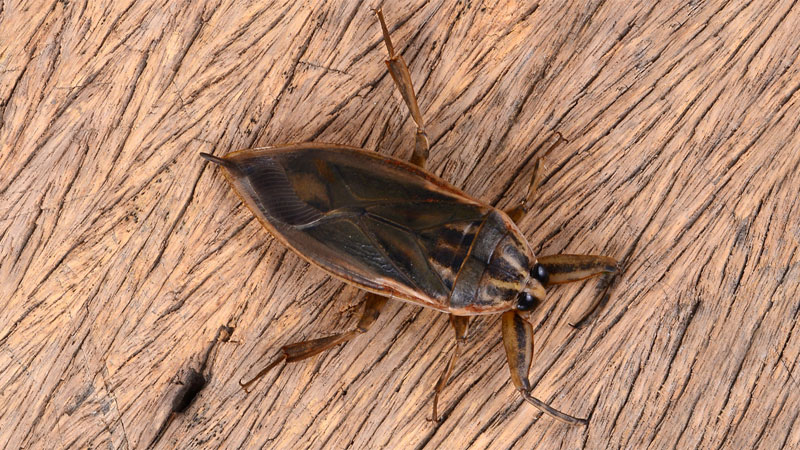
 Just tell me how to get rid of ’em.
Just tell me how to get rid of ’em.